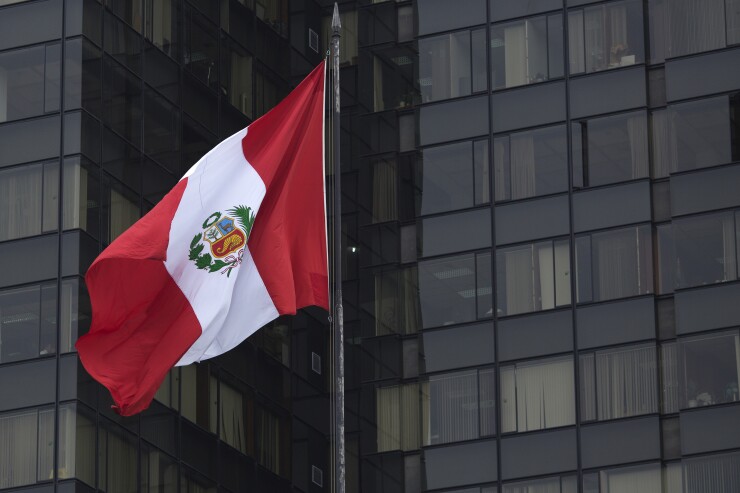Peru is planning a real-time payment system with Vocalink that will put the country on par with similar systems in Thailand, Singapore, the U.S. and the U.K.
In December, Mastercard's Vocalink subsidiary won a contract from Peru’s bank-owned ACH Cámara de Compensación Electrónica (CCE) to modernize the country’s payment infrastructure, including support for
Vocalink will upgrade CCE’s existing system, which is used to support clearing and settlement of checks, bulk payments and instant transfers. The London-based firm will also implement its Immediate Payment Solution (IPS), a platform that can process credit transfers in real time. Vocalink will operate and manage CCE’s new payments system from a data center in Peru.

“Firstly, we’ll replace Peru’s batch payment system,” said George Evers, Vocalink’s senior vice president of real-time payments. “Then we’ll install our IPS system, which is live in Singapore, Thailand, and the U.S. and supports the U.K.’s check clearing infrastructure launched in 2016.”
IPS is a core real-time switch which uses ISO 20022 in Singapore’s FAST service, Thailand’s PromptPay, and The Clearing House’s RTP service in the U.S. However, the U.K.’s Faster Payments system, which doesn’t use ISO 20022, was implemented before IPS’s development.
Thailand’s PromptPay went live two years ago with proxies such as email addresses, phone numbers and national identity numbers being used to direct payments. “PromptPay has seen huge take-up with 45 million registered users, and led to a significant reduction in cash withdrawals from bank branches,” said Evers.
The CCE is due to go live with Vocalink’s system by the end of 2019, with the new bulk payment system being implemented in Q3 2019 and the immediate payments service in Q4 2019.
Once Vocalink’s technology is implemented, Peru will have the most modern payments infrastructure in Latin America, Evers claimed, as Brazil and Mexico have yet to upgrade their existing real-time systems that were developed in the 2000s.
“Our current real-time system is only available during banking hours, but Vocalink’s platform will enable real-time payments at any time,” said Cesar Ferreyros, CCE’s chief executive.
Ferreyros said that, using Vocalink’s technology, CCE will offer services such as "request to pay," interbank loan payments, and fraud monitoring. In the last five years, CCE has seen a 25 percent compound annual growth in bulk payments over its network and a 150% compound annual growth in real-time payments, Ferreyros said.
“Cash reigns as king across Latin America,” said Erika Baumann, senior wholesale banking analyst at Aite Group. “But Peru’s CCE partnering with Vocalink to provide real-time 24/7 settlement across multiple payment types will have an impact on other Latin American countries, as it will set the bar for the region. A successful launch will quickly transform commerce in Peru, with new ways to more efficiently move money. I foresee a lot of innovation and creativity in how businesses use payments to differentiate themselves early on, especially in the B2C space. For business payments, small to medium-size businesses will gain greater transparency and control over their cash position while easily reducing days sales outstanding.”
CCE’s real-time payment system using cellphone numbers as proxies will co-exist with
ASBANC’s financial education institute is the majority investor in Pagos Digitales Peruanos, the company set up by Modelo Perú to operate BIM. The participants in Modelo Perú comprise 34 private-sector and state-owned banks, cajas (credit unions), and microfinance institutions; licensed nonbank electronic money issuers; and Peru’s four telcos.
According to ASBANC, in the second quarter of 2018, 39 percent of Peru’s population were banked, representing 5 percentage points of growth in the second quarter of 2015. ASBANC said the growth was a result of initiatives such as BIM.
BIM offers services such as P2P transfers, savings accounts, access to loans, phone top-up and tax payments. It provides a fully interoperable mobile wallet that is supported by all Peru’s telcos, FIs and e-money issuers. As BIM uses SMS and USSD (Unstructured Supplementary Service Data), it works with feature phones used by low-income consumers.
As of June 2018 BIM had 430,000 users and was adding 10,000 new users a month, according to Francesco Burelli, an independent payments industry expert.
Ferreyros said that eventually the P2P transfer service CCE is developing with Vocalink will integrate with BIM.
“Our system only allows transfers to bank accounts, while BIM is for unbanked consumers’ e-wallet accounts,” he said. “But, once we start allowing cellphone numbers to be used as proxies for bank accounts, that will bring us closer to BIM’s model. I estimate that within 18 months of launching our new platform we would be able to begin integrating with BIM.”





